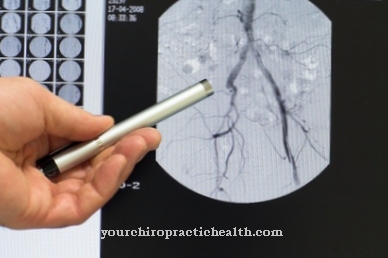As part of the Gene therapy Genes for the treatment of genetic diseases are inserted into a human genome. As a rule, gene therapy is used for pronounced diseases such as SCID or septic granulomatosis, which cannot be controlled by conventional therapeutic approaches.
What is gene therapy?

As Gene therapy is the term used to describe the insertion of genes or genome segments into human cells. It aims to compensate for a genetic defect for the treatment of hereditary diseases.
In general, a distinction can be made between somatic gene therapy and germline therapy. In somatic gene therapy, body cells are changed in such a way that only the genetic material of the cells of the body tissue to be specifically treated is modified. The changed genetic information is accordingly not passed on to the next generation.
In the context of germline therapy, which is banned in almost all countries, there is a change in the genetic information in cells of the germline. In addition, depending on the therapeutic strategy, a distinction is made between substitution therapy (exchange of defective genome segments), addition therapy (reinforcement of specific gene functions such as immune defense in cancer or infectious diseases) and suppression therapy (inactivation of pathogenic gene activities).
Since the gene sequence can be inserted permanently or temporarily into the target cell, the effect of a gene therapy can also be permanent or temporary.
Function, effect & goals
Generally one aims Gene therapy By exchanging the defective with an intact gene, the target cell is able to synthesize substances essential for the organism (including proteins, enzymes).
The substitution of the genetic material can be carried out outside the body (ex vivo). For this purpose, the cells that have the defect to be treated are removed from the affected person and equipped with an intact gene. The modified cells are then returned to the affected person. The gene transport into the cell can be ensured by various methods.
In what is known as chemical transfection, an electrical connection affects the cell membrane so that the therapeutic gene can get inside the cell. The modified genetic material can physically get into the cell interior through a microinjection or an electrical impulse that causes the cell membrane to temporarily permeate (electroporation). In addition, the changed information can be shot into the interior of the cell on small gold balls (particle gun).
As part of a transfection using erythrocyte ghosts, erythrocytes (red blood cells) are lysed with the therapeutic genes in a solution. As a result, the cell membranes open briefly and the gene sequence can penetrate. The changed erythrocytes are then fused with the target cells.
In addition, genetically modified viruses can be injected through what is known as transduction. Since viruses depend on the metabolism of a host to multiply, they can act as so-called gene shuttles by smuggling the new, healthy genetic material into the target cells. DNA, RNA and, in particular, retroviruses are used for the transduction process. Suitable target cells include liver cells, T cells (T lymphocytes) and bone marrow cells.
Gene therapy is mainly used for severe immune system diseases such as SCID (defective T lymphocytes) or septic granulomatosis (defective neutrophil granulocytes). It also represents a possible alternative therapy for tumors, serious infectious diseases such as HIV, hepatitis B and C, tuberculosis or malaria, whereby the therapeutic options, especially with regard to HIV and tuberculosis, are still being clinically researched.
The gene therapeutic transduction with retroviruses on the body's own blood stem cells is particularly suitable for beta-thallassemia (impaired beta-globin synthesis).
Risks, side effects & dangers
While few diseases are caused by a Gene therapy can be treated, on the other hand, the risks cannot be fully assessed in many cases due to the low level of development of the therapy.
The greatest risk in gene therapy lies in the hitherto undirected integration of the therapeutic gene sequence into the target cell. In the event of an incorrect integration into the genome of the target cell, the function of intact gene sequences can be impaired and other serious diseases can be triggered. For example, proto-oncogenes that adjoin the inserted gene can be activated, impairing normal cell growth and causing cancer (insertion mutagenesis).
The same could be observed, among other things, in a Paris study. After the initial success it was found that some children treated with gene therapy had leukemia. In addition, the immune system can mark the modified target cells as foreign and attack them (immunogenicity).
Finally, in the case of transduction with viruses, there is a risk that the person being treated with gene therapy will become infected with a wild type of the virus used as a ferry and that this will mobilize the genetically modified sequence from the genome to such an extent that it will match the corresponding in an undesired location Can integrate consequences.













.jpg)

.jpg)
.jpg)











.jpg)